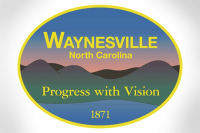State of the waterways: Water Quality Advisory Committee releases new report
 File photo
File photo
The Water Quality Advisory Committee has released its latest report detailing potential impacts of revising the Macon County Flood Damage Prevention Ordinance — the last of three such floodplain ordinances the county has considered revising this year.
The report comes just over a month after flooding and wind damage from Hurricane Helene ravaged Western North Carolina.
“We firmly oppose this change, and instead advocate for a variance process to allow for exceptions to the Flood Damage Prevention Ordinance, while keeping floodplain protections intact,” the Water Quality Advisory Committee wrote in its report.
The Water Quality Advisory Committee (WQAC) is charged by Commission Chairman Gary Shields with providing technical information and making recommendations related to proposed changes to Macon County’s Soil Erosion and Sedimentation Control Ordinance, Water Supply Watershed Protection Ordinance and the Flood Damage Prevention Ordinance.
Earlier this year, at the behest of members of the public who came to commissioners with complaints about a few aspects of these three ordinances, commissioners directed the planning board to review them as they were. The planning board came up with some recommended changes and put the ordinances, as well as the decision to revise them or keep them as they are, back in the hands of the county commission.
From the beginning of the process there has been regular and robust public opposition to the proposed changes. For this reason, even after holding a public hearing on all three proposed changes, Shields decided to slow down the approval process to allow for more public input and board discussion.
Related Items
The commission ultimately passed the first of the three proposed revisions at its August meeting, changing the required land disturbance from half an acre to an acre before any plans are required for soil erosion control on a project in the Soil Erosion Sedimentation Control Ordinance.
However, Shields decided to put the other two proposed ordinance revisions back before the planning board for further consideration prior to approval by the county commission and has said the board won’t act on either proposed change until January.
The WQAC presented findings from a similar report about potential impacts of revisions to the Water Supply Watershed Protection Ordinance at the planning board’s Oct. 3 meeting. Ultimately, the planning board voted against the recommendations of the WQAC and recommend removing the clause from the ordinance that says RV parks are not eligible for special nonresidential intensity allocations (SNIA) from the ordinance.
Now, the WQAC — made up of nine volunteer members with careers in varying aspects of aquatic management — is back with another report, this time on potential impacts of revising the Flood Damage Prevention Ordinance and is set to make its presentation to the planning board on Thursday, Nov. 7.
The report
The existing Flood Damage Prevention Ordinance explicitly prevents placement of fill in floodplains. The proposed change would permit fill on up to 25% of flood fringe area of any property.
At the June commissioners meeting, then Director of Planning and Code Enforcement Joe Allen explained how the 25% fill functions.
“So, if you have a 5-acre parcel and an acre of it was in the flood fringe, you would be allowed to fill .25 — a quarter of an acre,” Allen said.
The WQAC argues that the justification for the 25% standard is not clear.

Source: FEMA
“Is 25% any more a proper limit than 13% of 31%?” the WQAC wrote in its report. “What this committee can emphatically say, and give a sound scientific argument for, is that to allow any amount of fill whatsoever or other impediment that restricts, diminishes, or otherwise alters the natural flow of a stream under flood conditions causes damage to properties both upstream and downstream of the fill.”
The committee is primarily concerned that although the revision suggests 25% of a property can be filled in the flood fringe area, this does not account for the volume or height of the fill, nor does it account for property changing hands.
“What if 25% of a property is filled, and then the remainder is sold?” the WQAC asks. “Does the new owner have the right to fill 25% of that? This could easily lead to uncontemplated levels of cumulative damage.”
The stated objectives of the existing Flood Damage Prevention Ordinance are to protect human life, safety and health; minimize rescue and relief efforts associated with flooding; minimize business losses and interruptions; minimize damage to public facilities and utilities; maintain a stable tax base from floodplain land uses; and create transparency and public awareness of risk associated with flood-prone areas.
“It is the WQAC’s understanding that the proposed ordinance change is not intended to modify the current Flood Damage Prevention Ordinance’s stated objectives,” the report reads. “Intentions notwithstanding, it is the position of the WQAC that the proposed ordinance change runs counter to all of these stated objectives of the Flood Damage Prevention Ordinance. We feel that available information and data unequivocally indicate that downgrading the existing protections will introduce unacceptable risks and undermine long-term goals espoused by the Macon County Board of Commissioners.”
The report contends that the county could encounter enforcement difficulties and potential regulatory conflicts if the ordinance is changed as proposed. The WQAC states that determining allowed fill under the ordinance would be difficult and costly with no plan to record permitted fill for future property division owners.
Additionally, to qualify for the National Flood Insurance Program (NFIP), Macon County was required to make specific representations to FEMA regarding its floodplain ordinance. Included in this is the provision that no development occurs within the Regulatory Floodway, as defined by FEMA. This floodway is a subset of the 100-year flood zone, with the area outside the floodway but inside the 100-year flood zone referred to as the “flood fringe.”
According to the report, the 100-year flood zone has flooded multiple times in this century alone.
“The Macon County Floodplain Damage Prevention Ordinance (FDPO) was motivated by extensive losses associated with tropical storms Frances and Ivan in 2004,” the WQAC wrote in its report. “In western North Carolina, those storms caused 11 deaths and more than $200 million in total damages.9 Each of the two storms – which occurred ten days apart – met criteria for 500-year flood events at the time.”
The WQAC also found that the proposed change will encourage the loss of farmland, which runs counter to the county’s stated purpose in the Farmland Protection Plan it adopted earlier this year.
“The most productive farmland that we have is the bottomlands of this county; we don’t have a great deal of it, and in North Carolina, we are losing farmland faster than any state in the nation,” Kevin McCaskill of Macon County Farm Bureau told commissioners at their June meeting.
McCaskill has been a vehement opponent of the proposed ordinance revisions.
In its report the WQAC also outlines potential risks to water quality and ecosystem function, economic viability and costs to taxpayers.
In addition to its findings on potential risks of amending the ordinance, the WQAC outlines several recommendations in its report, the first of which is that the planning board and the commission do not accept the proposed revision to the Flood Damage Prevention Ordinance.
However, the WQAC does acknowledge that the existing ordinance has shortcomings, which “on occasion cause serious inconvenience to property owners.”
Therefore, the committee recommends the county create a variance policy in which people can apply for permission to put small amounts of fill on their property when necessary. The WQAC recommends the Board of Adjustments as the body to make decisions on variances.
Ultimately, the committee recommends that the county not accept current revisions to the Flood Damage Prevention Ordinance, but continue to work toward a stronger, clearer ordinance and a more efficient and effective enforcement process for all the ordinance associated with the floodplain.
“We are thankful that Macon County was spared the worst during Helene. In the counties and watersheds to the east, just the quantifiable effects are staggering,” the WQAC noted in its report. “Any accounting necessarily fails to quantify the psychological damage, the time robbed from people’s personal lives, the loss of productive activity, damage to the natural environment… Even here in Macon County, many of us felt compelled to make sacrifices in order to assist our neighbors. One has to ask — if Helene veered 40-60 miles to the west, would we even be having the conversation of relaxing the Macon County Flood Damage Prevention Ordinance?”













